Men's magazines: lad mags I
by Tony Quinn
In the history of men's magazines, the launch of Loaded in 1994 is the stuff of legend. It revolutionised magazine publishing in the UK – and the US when Dennis took 'lads' mags' there in the form of Maxim. In between came FHM, which trounced Loaded in the sales stakes in the UK and launched overseas. In 2004, another sector was spun off by IPC and Emap – men's weeklies, which sent monthly men's magazine sales into freefall. By 2007, the publishers of lads' magazines seemed at a loss to know how to stem the decline of their titles – but the free men's weeklies Sport, ShortList and digital-only Monkey had come along to win the circulation plaudits and suggest another business model for lads' mags. This case study puts all this history in context over almost a century, from the 1930s boom with Razzle, Men Only and London Opinion; to porn expansion with Mayfair and Penthouse; to The Face and Arena by Nick Logan with Neville Brody's designs that revived a mainstream lifestyle sector that had retreated to the top shelf in the 1960s.Men's magazines I:
Men's magazines II:
- Loaded defines the lads' mag
- The rise of FHM
- Table: Men's magazines by mid-1996
Men's magazines III:
- The advent of women
- A maturing men's magazine market
- Taking over the world
- Into the digital world
Men's magazines IV:
- IPC and Emap gear up
- Nuts – 'the world's first men's weekly'
- Emap follows with Zoo Weekly
- Building a new market -Cut and KO!
- Decline sets in
- A free way forward
- Table: Men's magazines: details and sales
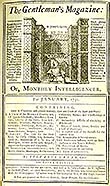 The Gentleman's Magazine
is often considered the first modern magazine. The cover shows St John's Gate in Clerkenwell, London, which is today the Museum of the Order of St John. See the Internet
Library of Early Journals for scans of this and other early titles
|
Early evolutionMen's magazines have existed for centuries. In terms of identifying the first one, it depends on how the terms 'magazine' and 'journal' are defined. Certainly journals, in the sense of discussing and communicating scientific matters, were around first; the question is: when did some of them split off to become magazines? The 1663 German publication Erbauliche Monaths-Unterredungen (Edifying Monthly Discussions) makes a claim as the world's first magazine. And, five years later, Giornale de' letterati di Roma, edited by Francesco Nazzari, is seen as the first Italian magazine. However, The Gentleman's Magazine is often considered the first modern magazine. It was published by Edward Cave (using the pen-name Sylvanus Urban) and printed at St John's Gate in London from 1731. It aimed to entertain, with essays, stories, poems and political comment. In 1755, Samuel Johnson's Dictionary credited Cave as coining the term 'magazine' (which had previously meant a storehouse or arsenal) in its publishing sense: 'Of late this word has signified a miscellaneous pamphlet, from a periodical miscellany named the Gentleman's Magazine, by Edward Cave.' The magazine was published by Punch publisher Bradbury & Evans until 1907.Many Victorian magazines were published for men. These included Gentleman's Magazine of Fashion, Fancy Clothes, Man about Town, Gentleman's Pictorial, The Gentleman (A Cosmopolitan Journal), County Gentleman and The Gentleman's Journal. Most focused on fashion, social life and the importance of being a gentleman. Many of these closed in 1914 with the advent of the first world war. However, Wide World, launched by George Newnes in 1898, was filled with 'true stories of peril and adventure' and survived until 1965. |
 Men Only in 1937
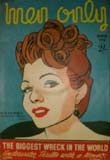 Men Only in
March 1958, still pocket-book sized: covers were colour illustrations,
like this one of Rita Hayworth, or photographs
Men Only in
March 1958, still pocket-book sized: covers were colour illustrations,
like this one of Rita Hayworth, or photographs
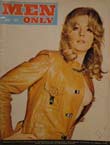 Men Only in June 1968. This City Magazines issue was in a larger A4-ish size 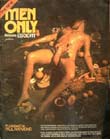 Men Only in
June 1971: the first of the truly top-shelf Paul Raymond era
Men Only in
June 1971: the first of the truly top-shelf Paul Raymond era
 Lilliput, in August 1943  Blighty, a 6d weekly, in May 1950 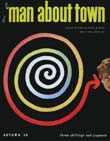 Man About Town in Autumn 1958  Hugh Hefner's Playboy launched in 1953 in the US  Penthouse appeared in 1965 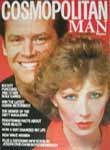 Cosmopolitan Man – only appeared once, in April 1978 |
In 1935, AC Pearson launched the pocket men's magazine, Men Only
(bound, 115x165mm). Its editorial strategy was clearly stated:
The cover was 'yapped', meaning it was slightly larger than the inside page size. Pearson was taken over by Newnes, and Men Only, which had become mildly saucy, faded from the mid-1950s, though not before it had taken over rivals such as The Humorist, The Strand and London Opinion. It was Men Only that published in the UK the pin-up illustrations by Alberto Vargas that appeared in US Esquire. (See Men Only case study.) Newnes, in turn, became part of International Publishing Corporation in the early 1960s. Men Only was bought by Leonard Matthews (who had been nicknamed 'Napoleon of the Comics' as director of Fleetway Publications). He had left IPC to set up Martspress, which specialised mainly in comics and children's books, and Men Only was published by City Magazines Ltd in Fleet Street. It was mainly in black and white with a colour pin-up centre spread. In 1971, Matthews sold the title to Paul Raymond, who ran night-clubs in London's Soho district. He relaunched Men Only as the start of a 'top-shelf' publishing empire. Back in 1937, Lilliput, a pocket magazine (stapled, 136x196mm), was put out by Stefan Lorant, who was later to create Picture Post, at Hulton Press. At sixpence, it was half the price of Men Only. It was intended for a general audience – subtitled 'The Pocket Magazine for Everyone' – but became a men's magazine after the second world war. It was a bestseller in its day, famous for its mix of photographs, reportage, cartoons and air-brushed nudes. In July 1960, it was merged into Men Only. Many issues have a page describing the contributors, who included people such as actor James Mason, Antonia White, Ronald Searle and Tom Driberg. The magazine cover was usually a cartoon in the 1940s and 1950s. Other men's titles included London Opinion, which merged with Men Only in 1954, Blighty (the weekly 'National Humorous Magazine') and Razzle (which published 'the brightest cartoons of them all' according to the magazine cover). In the US, Esquire was founded in 1933. It always stressed its intellectual side, but really established itself in the war years with its pin-up illustrations and calendars by Peruvian-born Alberto Vargas. The first fold-out pin-up appeared in October 1940 and his calendar that year sold 320,000 copies – by 1943 a million calendars had sold. (It was his work that inspired aircrews to paint women on the sides of their planes.) However, they fell out in 1946 and the magazine, which had persuaded him to sign his work as Varga, copyrighted that name to stop him using it. In 1957, Esquire spun off its Gentleman's Quarterly supplement, which was to end up in the hands of Condé Nast and overtake its parent in terms of sales. Esquire was bought by Hearst in 1986. Hugh Hefner's Playboy launched in 1953 in the US, selling for 50c. Marilyn Monroe was on the front cover and featured again, naked, inside. This thrived in the US and around the world. In 1953, Esquire made its first attempt to launch a British edition, but this folded after six years of trying. In the mid-1950s, all of the big men's magazines in the UK were in trouble because of the loss of advertising to television. Most of them were taken over by other titles or closed: Lilliput (Men Only, 1960); London Opinion (1954); Razzle (1954). However, there was a resurgence from the mid-1960s with launches such as King, Penthouse and Club, building on the growth in products aimed at men. Conde Nast launched Men in Vogue in November 1965. However, it was only the top-shelf titles that thrived; Men Only limped on to be taken over by Paul Raymond, who developed a strategy of buying up failed titles such as Razzle. Paul Raymond built up his stable from Men Only to include Club and Escort. Richard Desmond's Northern & Shell/Portland group moved on from Penthouse into niches such as Asian Babes and Forty-Plus (Northern & Shell profile). The model for mainstream men's magazines was Man About Town (see Man About Town and Town case study), an offshoot of the trade journal Tailor & Cutter. It was launched in 1952 by editor John Taylor. MAT mainly covered fashion but included other areas of lifestyle and became something of a cult publication. It counted such luminaries as Gerald Scarfe, Michael Heath, Calman, John Arlott, Raymond Postgate, Mark Boxer and Gilbert Harding among its contributors. It was sold in 1960 to Clive Labovitch and Michael Heseltine. As Cornmarket – later Haymarket Publishing – this duo made a great success of weekly trade magazine Campaign, which forced the closure of market leader Advertisers' Weekly. MAT was later abbreviated to About Town and then Town. At one stage it became a quintessential 1960s magazine, under art director Tom Wolsey, helping to establish photographers such as Terence Donovan and Don McCullin. However, like IPC's Nova, it was not very profitable and closed in 1968. The Writers' and Artists' Year Book of 1963 listed 70 'feminine' magazines (including nine from the Commonwealth and eight from the US), but just seven for men. Of these, four were aimed at tailors or the men's wear trade (Men's Wear, Outfitter, Style for Men and Tailor & Cutter), leaving Men Only, Town and Esquire (US) as consumer titles. The advent of television as a national advertising medium and colour magazine supplements in newspapers, led by The Sunday Times in 1962, took away the advertising base for men's magazines in the UK, though the top-shelf industry, which did not rely on mainstream advertising, grew. In 1965, King from Europress arrived. According to an obituary of journalist John Sandilands in the Telegraph, this was launched by Paul Raymond: 'Raymond baled out after the first issue, and Peter Sellers, Bryan Forbes, Bob Monkhouse, David Frost and others were persuaded to invest to keep it going.' It ran colour nudes – though not on the cover – but was swamped by the likes of Bob Guccione's Penthouse (also a 1965 launch) and was taken over by Mayfair (Paul Raymond, 1966) in 1967. IPC's Club tried to crack the men's market in 1970 but folded after 21 issues. The last issue noted: 'The shame is that Club's closing will probably make any other publisher wary of putting out a similar product for young men.' How true this was, with mainstream men's magazines disappearing for a decade. Of course, men didn't stop reading magazines. They read about
cars, sports, hobbies and businesses – and they read the likes
of Mayfair, Penthouse and Playboy, Men
Only and Club International. But,
for some things, they turned to women's magazines. Cosmopolitan publisher
the National Magazine Company noted that many men read their partner's magazine
and in April 1978 tried a one-off edition of Cosmopolitan
Man.
This had French actress Aurore Clément and Jack Nicholson
on the – rather crowded looking – cover and cost 50p. However,
there were no more issues.
|
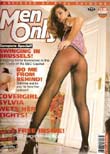 Magazines such as Men Only became synonomous with the phrase 'men's magazine'
|
The accepted wisdomBy 1980, and after the failure of IPC, Britain's largest magazine publisher, with Club, it was accepted wisdom that there was no market for a general interest men's title. Areas such as sport were well covered by the papers, and their magazine supplements, usually on a Sunday, but the Daily Telegraph had one on a Thursday. Men bought:
A spark for the launch was Paul Kerton winning Cosmopolitan's first Young Journalist's Writing Competition in 1977 and his suggestion to Cosmopolitan editor Deidre McSharry that they launch a version for men. 'Next minute I was in London working on it,' said Kerton. He added: 'The first standalone copy with Jack Nicholson on the cover had 60 pages of ads in it, and was deemed a success but management thought it was way ahead of its time. Also, Natmags were working on Company magazine at the time, which was originally slated to be a modern "couples mag", ie for men and women, which was to break the mould, but they chickened out at the last minute and made it a younger sister to Cosmopolitan.' Kerton then crossed over to Company along with Linda Kelsey and editor Maggie Goodman. So the term 'men's magazines' came to mean top-shelf and pornographic titles. Many more of these were launched, focusing on smaller, and weirder, niches. In May 1982, Executive came along as a Playboy-style title 'For the man of today' from Fragilion with editor Brian Keogh, but failed. However, in the mid-1980s, things were stirring. Many editors
and publishers found themselves at some stage discussing the
possibility of a general interest title for men over a pint
after work. It was a boom time, with champagne bars opening
all over the City of London. Men were staying single longer
and had more cash, particularly for clothes and toiletries.
They could turn to Viz for a laugh
(and did, its sales hitting almost a million), Q for music
and one of a dozen papers for sport and news. However, the
'new man' had nowhere to find fashion and grooming, and coverage
of sex and relationships was only in the women's weeklies
and glossies. 'Lifestyle' was becoming important, more men were
reading their partner's favourites, and many did not want to be
seen with top-shelf magazines. So some titles began to explore
the gap. |
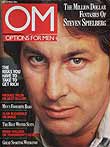
Steven Spielberg in the
first issue of Options for Men (Dec 1984)  Mel Gibson and Tina Turner from Mad Max Beyond Thunderdome in Cosmo Man (1985)  Company for Men: (Dec 1979) 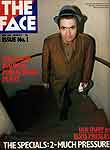 Nick Logan's The Face first issue in May 1980 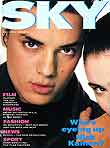 Sky – Murdoch must have liked the name
Sky – Murdoch must have liked the name

At Emap, Sky became more overt but closed in 2001 |
Exploring the gapBy the mid-1980s, there was undoubtedly some kind of a market among men for a magazine. In fact, in terms of magazine history, there was a massive gap because there were no general interest men's magazines. Men were addressed by newspaper supplements and supplements or special sections in the women's glossies, which found up to a quarter of their readers among men. The idea of Cosmopolitan Man was revived by NatMags as Cosmo Man and published as a section inside Cosmopolitan and as a banded supplement (produced by Paul Kerton and Paul Keers, who had won Cosmopolitan's young journalist writing competition the year after Kerton). Cosmo Man was also published in various other countries as a male supplement to Cosmopolitan. Both Elle and Harpers & Queen had sections for men in each issue. The mainstream publisher that came closest to a launch at this time was probably Reed subsidiary Carlton, which first put out Options for Men as a supplement to women’s monthly Options in December 1984. Carlton's managing director was former Club editor Terry Hornett. Options for Men covered fashion, motoring, sport and entertainment. It was produced by Sally O'Sullivan, editor of women's monthly Options. The company had hopes of a standalone quarterly in 1985, though this did not come about. However, OM went out as a supplement three times in 1985 and 1986 and was quarterly in 1987, which led the company again to talk of a launch in 1989, but it did not see the light of day. Similarly, the National Magazines women's monthly Company ran a supplement, Company for Men in 1979 and 1980. So, none of the big publishing guns was able to get to grips with men's lifestyle magazines. Instead, it was left to a much smaller publisher, who acted on instinct. In 1980, Nick Logan had launched The Face, using £12,000 he raised by mortgaging his house (Emap had turned the idea down) – though Nick Logan correced this version of events in an interview at Test Pressing. The Face called itself 'a visual-orientated youth culture magazine' and was the sort of magazine he wanted to read. He had edited New Musical Express for IPC and invented Smash Hits for Emap. This background showed in the music focus of the early issues. It was in the right place – and had the right designer in Neville Brody – to become the 'house magazine' of the New Romantics, Boy George and the clubbing scene. By the late 1980s, The Face had become a style bible for the under-25s and was selling 88,000 copies a month. Other style titles, Blitz and i-D had come along. IPC tried to get in on the act with the short-lived The Hit in 1985. Rupert Murdoch's News International magazine division got in on the act with a pan-European youth magazine Sky, in a joint venture with French group Hachette, led by publisher Peter Jackson. This started out as a fortnightly for 16 to 25-year-olds in February 1987, but failed to meet a 200,000 sales target and was cut back to a monthly in November. Its audience was refined to 18 to 22-year-olds. (Murdoch was to pull out of magazine publishing, and the Hachette partnership, which included Elle, was taken up with Emap, until 2002. Sky closed in 2001) |
|
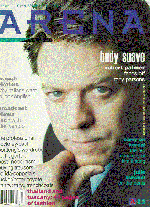 Arena ran male
covers for years 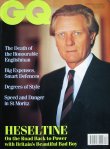 GQ: with a Tory cover model 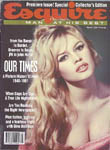 Esquire: the only woman around |
Men's lifestyle arrivesHowever, male readers who grew too old for The Face still had nowhere to go, so Logan thought up Arena magazine as a quarterly, niche title, with a mix of fashion, fads and fiction, and again designed by Neville Brody. It hit the streets in 1986.Peter Howarth, a later Arena editor, has said there was no conscious decision to make a male version of existing women's magazines. 'Nick Logan, launched The Face in 1980 because it was a magazine he wanted to read. But six years on he wanted to read a different magazine because he had moved on – as had all The Face readers – so he decided to do a men's magazine. It was never really a gap in the market; he just wanted to make the sort of magazine he wanted to read.' Despite industry scepticism, Arena was an instant success, later editor Dylan Jones wrote in the Independent ('Men on a monthly cycle,' 18 June 1996, p18): 'When Arena launched in 1986, it caused a huge media stir, not only because it was the first general-interest magazine to be launched in the UK since the demise of Michael Heseltine's Town in the sixties, but because it was also launched at a time when any men's magazine that didn't rely on pornography was considered commercial suicide. But Nick Logan, the publishing wizard who had conquered the youth market with the NME, Smash Hits and The Face, proved everybody wrong. After six months, his brainchild was selling more than 50,000 copies. Launched on a wing and a prayer, it gained a circulation of more than 65,000 in its first year, proving that the Bermuda triangle of British publishing was nothing more than a myth.' Yet, in November 1988, the strain of having a second title led Logan to sell 40 per cent of his company, Wagadon, to Vogue publisher Condé Nast. He said at the time: 'The magazines are still under our control. But the deal will allow us to grow at a natural pace, knowing there's a cushion of support under us. It also takes away the administrative burden, which has doubled since the launch of Arena.' Arena was selling 66,500 copies an issue and
was a spur for Condé Nast to launch the British edition of GQ a
year later. However, Logan denied being formally involved. Another attempt to crack the market was made by Excel in April 1988. However, its main coverline 'How to spot a bullshitter' led to its advertising being banned on the London Tube and the editorial mix under Rod Fountain was seen as too yuppy and it soon folded (although the title would be used again more than once in the next decade). The plethora of top-shelf magazines led to a campaign against them, led by Labour party politician Clare Short (who was to become a minister in Tony Blair's government, until she fell out over the Iraq war and resigned in 2003). The mainstream sector was given a boost by the arrival
of the big guns, first Condé Nast with GQ in
1989 and National Magazines' Esquire in 1991. Arena went bimonthly
just after GQ's launch (as a bimonthly) with sales of 70,000. In the UK, GQ magazine started out under editor Paul Keers with a straight interpretation of the US title's original name: Gentleman's Quarterly. Keers had worked on Cosmo Man. His cover 'babe' was Conservative politician (and founder of publisher Haymarket) Michael Heseltine. (There was a certain irony here, given Heseltine's attempt to address the men's market 30 years earlier with Town.) The first issue sold 90,000 copies, suggesting a settle-down figure of 63,000. The company's target was 50,000. Most of Arena's readers were under 30, with GQ aiming for men in their mid- to late-thirties with enough money to attract top-quality advertisers. Stephen Quinn, GQ's publisher, identified economic and political factors in making the launch possible: 'There are indications that the time and mood is right. Mrs Thatcher seems to have re-invented this enterprise culture in Britain that has led to a growth of business success which has required more professional men to service it.' The target readers would have more disposable cash to spend after the recent lowering of the top rate of income tax. Interestingly, Quinn had moved from National Magazine to Condé Nast in 1987 after a rumoured launch of Esquire in the UK had fallen through. The Financial Times (‘Observer: Male Vogue’, 9 November 1988) reported that US GQ had 'had a little problem around 1980 when it flirted with the gay market, but a new publisher soon put a stop to that'. So Keers and Quinn went for a resolutely macho image. Getting it right was tricky. Keers argued that being super-macho wouldn't dissuade anyone from sampling the first issue but later felt that it was 'over masculine' with features on boxing, dog fighting and the Cresta Run. Although he added: 'It would have concerned us a great deal more if we'd been too effeminate.' Along with the fashion, he was looking for gritty issues, such as testicular cancer and innocent men being accused of rape. As well as having to avoid a gay stereotype, the men's titles had to avoid being seen as what had been up to then 'men's magazines' – the pornographic titles. So both Arena and GQ continued with men on the cover, including actors John Hurt and Terence Stamp, and high-achievers such as broadcaster John Birt, musician Peter Gabriel and writer Martin Amis. By issue seven, GQ had its second editor, Alexandra Shulman and had gone monthly. It continued an all-male cover policy and cover lines had become more aggressive: a full-face image of Sean Connery was graced with the cover line 'Are you hard enough' (February 1991). Yet, a couple of months later, it ran what was probably the most boring men's magazine cover of all time – of Tory prime minister John Major (April 1991). Meanwhile, For Him hardened up its editorial approach to compete in the expanding market and introduced a sports supplement. It went monthly and changed its name to FHM. This coincided with the arrival of the next entrant: Esquire in March 1991 from Cosmopolitan publisher National Magazines. It was another US import with Lee Eisenberg as editor-in-chief and Alex Finer as editor. Unusually, it had a woman on the cover – a late-1950s photograph of Brigitte Bardot. By mid-1993, the leading two were heading for 100,000 sales a month: GQ (94,084); Arena (90,790); Esquire (74,771); and FHM (no certified figure, but estimated at 60,000 under editor Francis Cottam). Competition for advertising came from newspaper supplements, such as The Sunday Times Magazine and the Daily Mail's You. However, these were not lads' mags. They were refined titles, upmarket and based on fashion, which could not command broad appeal, in the way that Cosmopolitan and Marie Claire could do among women. However, the lads' magazines, in the shape of James Brown's Loaded, were about to arrive and change the history of men's magazines. |
|




